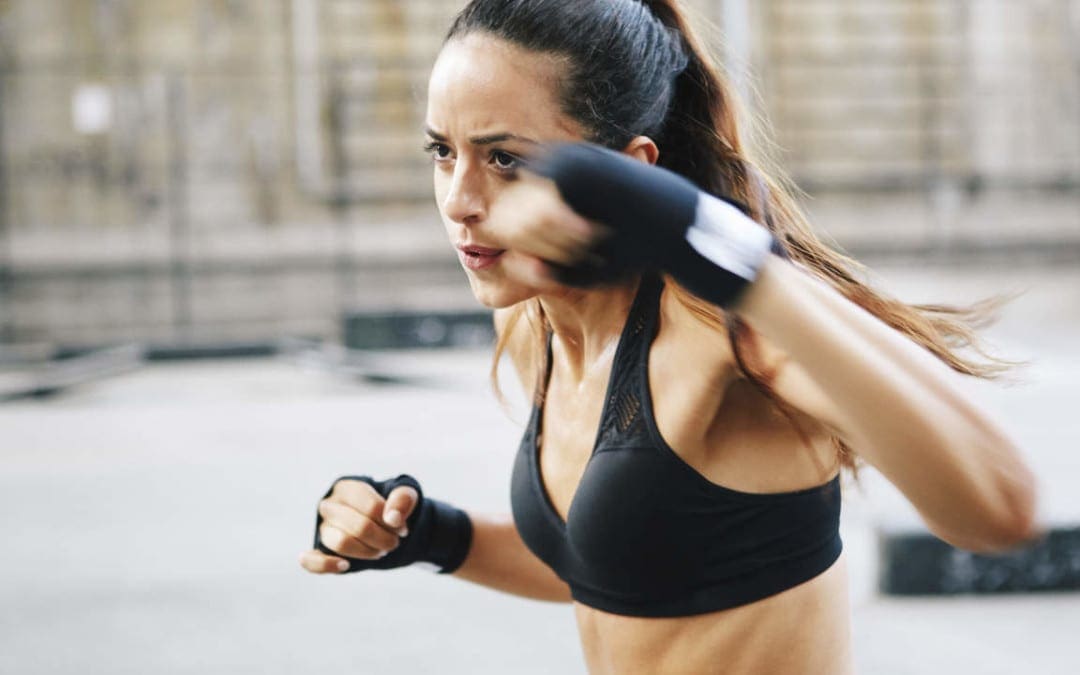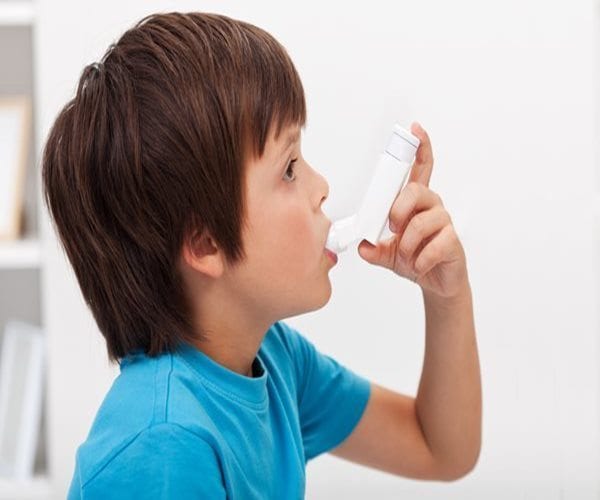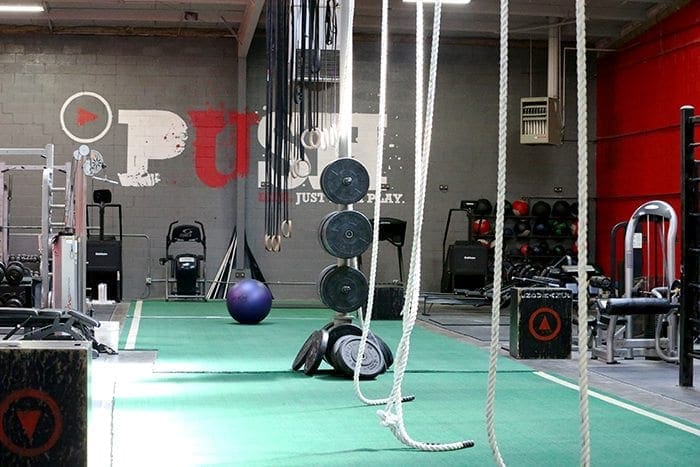Fitness
Back and Spinal Fitness at PUSH as Rx leads the field with a laser focus on supporting our youth sports programs. The PUSH-as-Rx System is a sport-specific athletic program designed by a strength-agility coach and physiology doctor with a combined 40 years of experience working with extreme athletes.
The program is the multidisciplinary study of reactive agility, body mechanics, and extreme motion dynamics at its core. A clear quantitative picture of body dynamics emerges through continuous and detailed assessments of the athletes in motion and under directly supervised stress loads.
Exposure to the biomechanical vulnerabilities is presented to our team. Immediately, we adjust our methods for our athletes to optimize performance. This highly adaptive system with continual dynamic adjustments has helped many of our athletes return faster, stronger, and ready post injury while safely minimizing recovery times.
Results demonstrate clear improved agility, speed, decreased reaction time with greatly improved postural-torque mechanics. PUSH-as-Rx offers specialized extreme performance enhancements to our athletes no matter the age.

by Dr Alex Jimenez DC, APRN, FNP-BC, CFMP, IFMCP | Diets, Fitness
People with celiac disease have to avoid most grains, but oats may be an exception that’s safe, according to a recent research review, so long as the oats are uncontaminated by traces of other grains.
More studies are needed to see whether so-called pure oats available in the real world don’t provoke celiac symptoms. If proven safe, oats could provide celiac sufferers some of the benefits of eating grains that they miss out on following a gluten-free diet, researchers say.
“Oats, compared to other cereals, are a source of good quality proteins, vitamins and minerals and they improve palatability and the texture of gluten-free food,” said study coauthor Dr. Elena F. Verdu.
“For a person diagnosed with celiac disease, adding oats to a gluten-free diet could not only increase food options but also help them follow a better gluten-free diet and have a higher quality of life,” said Verdu, a gastroenterology researcher at the Farncombe Family Digestive Health Research Institute at McMaster University in Hamilton, Canada.
Celiac disease is an autoimmune disorder that affects roughly one of every 100 people in the U.S. For sufferers, consuming even trace amounts of the gluten protein in wheat, barley and rye can trigger an immune response that damages the intestines. Over time, this immune attack can lead to malnutrition, osteoporosis, chronic inflammation and a variety of other problems.
People with celiac disease are also at heightened risk of heart disease and some recent research suggests that might be in part because avoiding gluten causes them to miss out on the heart-protective benefits of eating whole grains.
Oats don’t contain the same celiac-provoking protein found in other grains, the study team writes in the journal Gastroenterology. However, Verdu told Reuters Health, issues have been raised regarding potential adverse reactions to oats by celiac patients, and this has reduced the enthusiasm of adding oats to the gluten-free diet in many cases.
“The first study suggesting that oats may be harmful for patients with celiac disease was published more than 50 years ago. Since then, the addition of oats to a gluten-free diet has remained clouded in controversy,” she said in an email.
For this reason, the review team decided to evaluate the existing evidence. They re-analyzed data from 28 previous studies that included oats in gluten-free diets for people with celiac disease. Eight of the studies were controlled clinical trials; the rest were observational.
The researchers looked at any negative effects on symptoms or blood tests for up to one year of oat consumption.
“In our study, we found no evidence that addition of oats to a gluten-free diet affects symptoms or activates celiac disease. However, it is very important to stress that there were few studies in some of the analyses, the quality of the studies was low and most of them were conducted outside of North America,” Verdu said.
Although the consensus is that pure oats are safe for most patients with celiac disease, contamination with other cereal sources that may contain gluten needs to be avoided, Verdu added.
“The purity of oats will depend on the country of origin and local regulations, and this is why we were surprised to see that most recommendations in North America are still based on studies performed in Europe,” she said.
“Patients who follow a gluten-free diet are sometimes able to consume small quantities of gluten-free oats without adverse reaction,” said Hannah Swartz, a clinical dietitian at Montefiore Medical Center in New York who wasn’t involved in the study.
“Patients who have the most success with including oats in their diet ensure the oats are certified gluten free, and wait one or more years after following a gluten free diet to ensure that gut inflammation has subsided,” she said.
“Patients with celiac disease must first ensure that the oats they are adding are certified gluten free oats. Regular oats used in products that are labeled ‘gluten free’ such as some mainstream cereals are not recommended for patients with celiac disease as there remains the possibility of cross contamination with gluten containing grains during the processing of the oats,” she said.

by Dr Alex Jimenez DC, APRN, FNP-BC, CFMP, IFMCP | Fitness, Health, Wellness
Anyone who’s tried Zumba knows what a fun, heart-pumping workout it is. Thanks to the lively music and challenging dance moves, these classes help burn calories and strengthen your body from head to toe. But before Zumba classes started appearing everywhere, there was samba reggae. This music genre (which combines Brazilian samba with Jamaican reggae) originated in Bahia, Brazil.
And of course, what’s music without some dancing? It’s no surprise this upbeat music gave rise to a style of dance with a similar name. Samba reggae is upbeat, fun, freeing, and all about connecting with your body and the rhythm of the music.
RELATED: 5 Heart Pumping Samba Moves That Burn Fat
Ready to rock this dance for yourself? In this video, dance teacher Quenia Ribeiro of the renowned dance school Ailey Extension demonstrates an easy-to-follow samba reggae workout to get your heart pumping and body flowing. Just hit play and follow-along.

by Dr Alex Jimenez DC, APRN, FNP-BC, CFMP, IFMCP | Fitness, Health, Wellness
Boxing is all the rage right now—everyone from models like Gigi Hadid and Ashley Graham to celebs like J.Lo and Demi Lovato have picked up the powerful workout as their go-to way to stay fit. And they’re definitely on to something. Boxing is great way to up your heart rate and tone your body from head to toe.
It’s no coincidence that so many people who love boxing rock killer physiques. Boxing (as well as the challenging conditioning work that goes along with training) strengthens and sculpts the entire body. That’s because boxing isn’t just about aggressively throwing punches—it’s an amazing total-body workout that tightens and tones everything from your arms to your core.
RELATED: 5 Heart-Pumping Samba Dance Moves That Burn Fat
That said, stepping into a boxing gym or class can be a bit intimidating if you’re a total newbie. So Health teamed up with two-time boxing world champion Chris Algieri to get the lowdown on must-know boxing basics. Watch this video to learn everything from how to get in fighter stance, throw a 1-2 punch (also known as a jab-cross), and master other classic moves, such as upper cuts and hooks. Whether you’re a boxing novice or just looking to perfect your form, here’s what you need to know for a total knockout workout.

by Dr Alex Jimenez DC, APRN, FNP-BC, CFMP, IFMCP | Diets, Fitness
The idea that diet could have a role to play in preventing the signs of asthma is starting to gain ground, with studies highlighting certain deficiencies in patients or warning against the consumption of certain foods. On World Asthma Day, May 2, Relaxnews spoke to Dr. Bertrand Delaisi, a pediatric pulmonologist at Clinique Marcel Sembat in Boulogne-Billancourt, France, for an overview of what’s currently known on the subject.
The prevalence of asthma has increased considerably in recent decades, in parallel with changes in lifestyles and dietary habits, tending towards diets rich in carbohydrates and fat, and low in fiber.
As well as pollutants, allergens, passive smoking and air pollution, allergy specialists are increasingly interested in how diet can promote or modify the development of asthma on a physiopathological level.
Eating ham, cured sausage or smoked meats at least four times a week could aggravate the symptoms of asthma over time, concludes a study carried out by researchers at Inserm, the French National Institute of Health and Medical Research, published in January in the medical journal Thorax.
On the contrary, consuming fiber may influence the gut flora and could reduce inflammation in the bronchial tubes. A diet rich in fruit and vegetables and vitamin C — and especially vitamin D (calf’s liver, soy, egg yolks) — could, therefore, help limit the risks of asthma, according to Dr. Bertrand Delaisi, a pediatric pulmonologist at Clinique Marcel Sembat in Boulogne-Billancourt, France.
The same goes for omega-3 fatty acids, present in oily fish and other foods (walnuts, canola oil), which can relieve inflammation, including in the respiratory airways. People whose diets are rich in omega-3 have a lower risk of suffering from asthma than those whose intake is limited. They could also be beneficial to people who already suffer from the condition.
Foods containing quercetin could reduce the frequency of asthma attacks, as this antioxidant flavonoid is an anti-inflammatory. Studies carried out in vitro found that quercetin inhibited the liberation of inflammatory substances by mast cells, which play a role in allergic reactions, mirroring certain anti-asthma medications. This antioxidant is found in onions, mustard oil, tea and apples.
An estimated 300 million people worldwide suffer from asthma.

by Dr Alex Jimenez DC, APRN, FNP-BC, CFMP, IFMCP | Athletes, Fitness, PUSH-as-Rx
PUSH as Rx owner and exercise physiologist, Daniel Alvarado opens up about what PUSH as Rx means to him and what they have to offer.
- Crossfit
- Weight Loss
- Strength Conditioning
- Athletic Training (Any Sport)
- Cardiovascular
- Elderly Fitness
- Nutrition

by Dr Alex Jimenez DC, APRN, FNP-BC, CFMP, IFMCP | Fitness, Health, Wellness
Make the most of your rest days
Help your body recover with these self-care strategies from pros.
Eat well and hydrate: “You should be feeding your body nutrient-dense foods, like lean proteins and veggies,” says Rosante. “And be sure to drink plenty of water.”
Use a foam roller: “Imagine knots on a rubber band�trigger points are like that, and exercising can inflame them,” notes Rosante. “Rolling out breaks them up so you cna move better.”
Walk around: “Long walks help increase blood flow to the muscles,” explains Rosante, “bringing oxygen to fix damaged tissue.”
Don’t binge on junk food: “A rest day is not a cheat day,” notes Holder.
Don’t stay up all night: “Sleep is key for your body to recover, repair�muscles, and reset the brain,” says Holder. “Not getting enough can increase food cravings and push your body into chronic stress mode, making it harder to meet your goals.”
Don’t train�duh!: Sounds simple, but it can be challenging. Proper rest optimizes the body for future workouts. And don’t worry: “No gains will be lost in one or even two days,” adds Jon-Erik Kawamoto, founder of JK Conditioning in Newfoundland, Canada. To put it another way: Namaste…in bed.

by Dr Alex Jimenez DC, APRN, FNP-BC, CFMP, IFMCP | Fitness, Health, Wellness
When the going gets tough, yoga. That’s our mantra this spring—and this flow is proof that deep breaths and a little movement can work wonders on your energy levels. It’s led by Tiffany Cruikshank, founder of Yoga Medicine and an expert in the restorative power of yoga. The sequence is meant to wake you up, and help you find your center; so you finish your practice calmer than before, but also invigorated. The routine will also help you feel more connected to your body, as you challenge your muscles and build stamina.
While yoga doesn’t raise your heart rate quite like high-intensity interval training, or HIIT, it does come with its own set of stellar health benefits. Regular yoga sessions can help to reduce migraines, improve sleep quality, and even boost your sex life, thanks to poses that strengthen the pelvic floor muscles (and in turn make your orgasms bigger and better).
RELATED: 3 Yoga Poses to Relieve Stress and Anxiety
Of course yoga has the power to change your body for the better too. The ancient practice can lead to longer, leaner muscles, since it stretches your limbs while building strength simultaneously.
Want to get it on the action? Watch the video to follow along as Cruikshank guides you through a yoga flow that will recharge your batteries stat. It’s perfect for vinyasa novices as well as longtime yogis. Whether you do this routine first thing in the morning, or right in the middle of your afternoon slump, it will leave you feeling healthier and happier, guaranteed. And if you just can’t get enough of Tiffany, visit YogaGlo for more of her classes.












